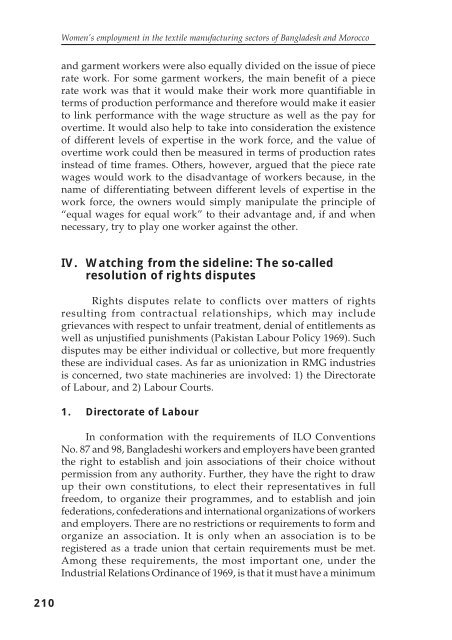Women's Employment - United Nations Research Institute for Social ...
Women's Employment - United Nations Research Institute for Social ...
Women's Employment - United Nations Research Institute for Social ...
Create successful ePaper yourself
Turn your PDF publications into a flip-book with our unique Google optimized e-Paper software.
Women’s employment in the textile manufacturing sectors of Bangladesh and Morocco<br />
and garment workers were also equally divided on the issue of piece<br />
rate work. For some garment workers, the main benefit of a piece<br />
rate work was that it would make their work more quantifiable in<br />
terms of production per<strong>for</strong>mance and there<strong>for</strong>e would make it easier<br />
to link per<strong>for</strong>mance with the wage structure as well as the pay <strong>for</strong><br />
overtime. It would also help to take into consideration the existence<br />
of different levels of expertise in the work <strong>for</strong>ce, and the value of<br />
overtime work could then be measured in terms of production rates<br />
instead of time frames. Others, however, argued that the piece rate<br />
wages would work to the disadvantage of workers because, in the<br />
name of differentiating between different levels of expertise in the<br />
work <strong>for</strong>ce, the owners would simply manipulate the principle of<br />
“equal wages <strong>for</strong> equal work” to their advantage and, if and when<br />
necessary, try to play one worker against the other.<br />
IV. Watching from the sideline: The so-called<br />
resolution of rights disputes<br />
Rights disputes relate to conflicts over matters of rights<br />
resulting from contractual relationships, which may include<br />
grievances with respect to unfair treatment, denial of entitlements as<br />
well as unjustified punishments (Pakistan Labour Policy 1969). Such<br />
disputes may be either individual or collective, but more frequently<br />
these are individual cases. As far as unionization in RMG industries<br />
is concerned, two state machineries are involved: 1) the Directorate<br />
of Labour, and 2) Labour Courts.<br />
1. Directorate of Labour<br />
In con<strong>for</strong>mation with the requirements of ILO Conventions<br />
No. 87 and 98, Bangladeshi workers and employers have been granted<br />
the right to establish and join associations of their choice without<br />
permission from any authority. Further, they have the right to draw<br />
up their own constitutions, to elect their representatives in full<br />
freedom, to organize their programmes, and to establish and join<br />
federations, confederations and international organizations of workers<br />
and employers. There are no restrictions or requirements to <strong>for</strong>m and<br />
organize an association. It is only when an association is to be<br />
registered as a trade union that certain requirements must be met.<br />
Among these requirements, the most important one, under the<br />
Industrial Relations Ordinance of 1969, is that it must have a minimum<br />
210
















